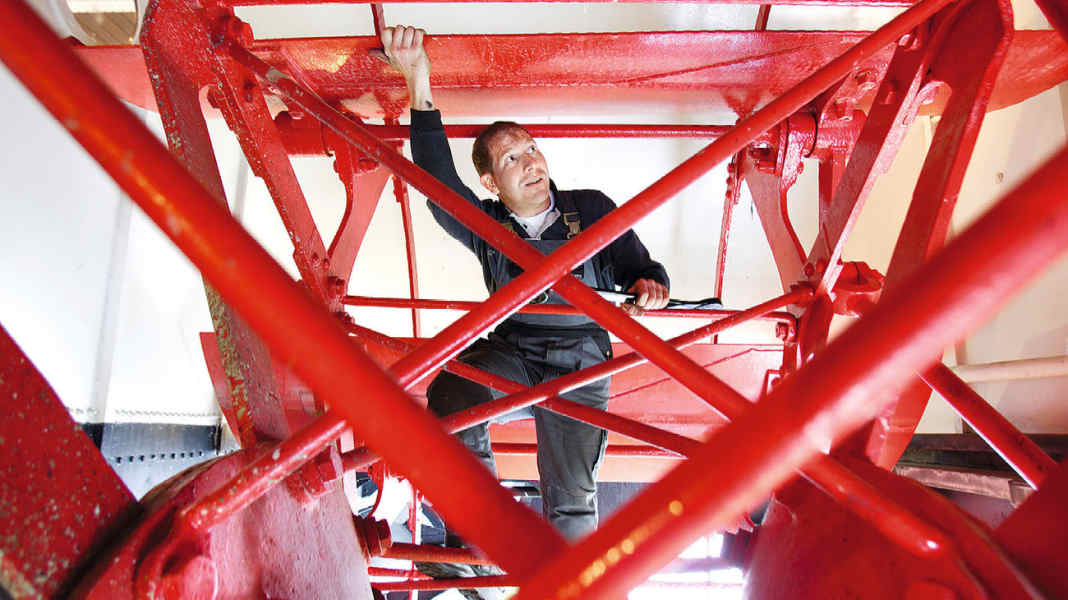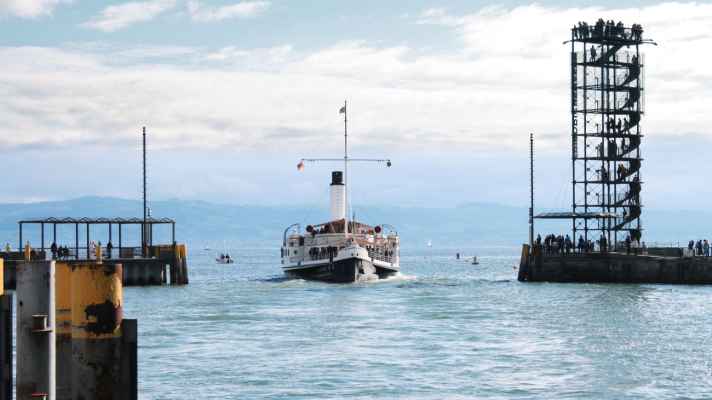
Without him - nothing would work. Christian Hämmerle grins mischievously when he hears such sentences. Then the man who can laugh so heartily says: "Not without him over there either." The 50-year-old should know: Christian Hämmerle has been an engineer on the majestic "Hohentwiel", the last paddle steamer on Lake Constance, for 25 years and hasn't regretted a minute of it. Above him, in the truest sense of the word, is chief captain Robert Kössler. On board the steamer, which was built in 1913 for the King of Württemberg, he gives the chief engineer, who is standing in front of the shiny black engine in the engine room two storeys below at a room temperature of 40 degrees Celsius, the order "Very slowly ahead" over the speaking tube from the driver's cab. The chief machinist repeats the order and carefully adds steam to the engine. This is followed by: "Engine stop!" The engine is switched to "reverse" and the engine driver uses the auxiliary steam lever to bring the powerful engine into the correct starting position. A bell sounds: the captain has just given the order to depart via the engine telegraph. The chief engineer confirms the order and the bell stops ringing. He then operates the main steam lever. "Jeee tu, jeee tu" - the steam slowly flows in and out of the carefully maintained and cared for engine. The paddle wheels begin to turn, adjusting to the ever faster "inhaling and exhaling". Spray splashes against the small portholes behind which the paddle wheels work. The "Hohentwiel" picks up speed and glides into a beautiful evening with a marvellous sunset against the backdrop of the Swiss mountains. Once again, the now unique original steam engine, built by Escher and Wyss & Cie Zurich and Ravensburg almost 110 years ago, is in top form. Without any electricity, gas or wood - the 360-tonne steamer travels across the lake with its crew and passengers using steam alone as its energy source. The chief engineer is beaming. He and the elegant old lady with the characteristic chimney - they get on brilliantly. The "Hohentwiel" was decommissioned in 1962, saved from the blowtorch at the last minute thanks to the commitment of a few visionaries and named the best-restored ship in Europe after its second launch on 17 May 1990. Not a single trip has had to be cancelled for technical reasons in the past 25 years.
Christian Hämmerle. Short hair, tall, athletic, strong hands. When he hears the word "Hohentwiel", his eyes light up. When he talks about their machine, they light up. He has been interested in technology since he was a boy. "My father, who is a mechanic and electrician by trade, used to bring home old punch card machines. We took them apart together," he says. The two of them removed cogwheels and magnets, for example, and put them back in somewhere else. So it's no surprise that Christian Hämmerle completed an apprenticeship as an electromechanic/mechanical engineer and then became a machinist at the Dornbirn cable car company. "One evening, the deputy operations manager came into the machine room where I was on duty," recalls Christian Hämmerle. His boss opens a newspaper. It contained an advert for a machinist for the "Hohentwiel". He tells the young man that he is thinking about applying. When the boss leaves, Christian Hämmerle opens the folded newspaper again. "I didn't feel the need to change jobs," he recalls. "Nevertheless, I decided that I would apply."

Reinhard E. Kloser, project manager of the extensive restoration and captain of the majestic steamer at the time, shows the young man the ship, which Christian Hämmerle has never set foot on before. When he enters the engine room, he is overwhelmed. Reinhard E. Kloser, who is also an expert in shipping, instinctively senses that Christian Hämmerle is the right man for the old lady. Two months later, he starts work on the "Hohentwiel", which belongs to the International Lake Constance Maritime Museum Association. The deputy operations manager of the cable car company is gobsmacked. It wasn't meant to be like that, he explains to Christian Hämmerle as he says goodbye.
He doesn't have much time to think about it. The captain familiarises him and the other newcomers. Three days before the start of the season, the men wake the machine from hibernation and, after the water pumps have been running for about an hour and a half, slowly pressurise the boilers - the iron must have time to expand. At the same time, the water warm-up phase must not take too long, otherwise the seals could become difficult. The operating temperature is reached at 186 degrees Celsius and a pressure of ten bar in the boilers. The maximum heat output is around 10,000 hp. The team is highly focussed. Experience, which few people still have today, is essential, as there is no computer to control the steam engine.
If the boiler is still warm from the previous operation, the chief engineer and the second engineer are on board around two and a half hours before the start of the journey. If not, the two of them start another hour earlier to slowly ramp up the boiler and preheat the machine, a huge cast iron block. Reinhard E. Kloser soon lets Christian Hämmerle drive the machine on his own responsibility. That weighs heavily. The chief machinist knows that. And yet he is happy to carry it - as with the cable car, maintenance and operation require manual labour. "I liked it right from the start," recalls Hämmerle. Together with two other machine operators, he looks after and maintains the machine and fills the many drip oilers. Because there is no monitoring equipment on board, the machine operators - currently Florian Pausch and Conny Simma, the first woman in the technical crew - must be able to hear and see any irregularities immediately. For example, if a bearing is running hot, they must react immediately. "Christian Hämmerle realises immediately if something is wrong with the machine. He can empathise with it," former captain Adolf F. Konstatzky once praised.
Although the main focus is on the machine, there are other tasks for the machine operators: they climb into the two red bucket wheels, which have a diameter of around four metres, and check all the bearings, nuts and bolts. Auxiliary units such as the steering gear or the generators also need to be maintained, and the drinking water supply must be hygienically safe.
On the lake, the crew is in uniform - just like in King's time, when the crew members were recruited by the imperial navy. This also involves manoeuvring, which requires a great deal of knowledge, skill and teamwork between the captain or helmsman and the engineer. Because the latter has to implement what the former sets out to do.

"If you compare the paddle steamer with a modern ship, the image of a heavy goods vehicle and bicycle fits best," says Reinhard E. Kloser, senior captain of the "Hohentwiel". If the paddle steamer is travelling forwards, both paddle wheels run synchronously when travelling forwards. If the ship has to travel backwards, such as in Friedrichshafen after mooring at Place 2, a stern line is attached to the corner and mooring bollard, which is used to "pull" the ship around the bollard - which always causes quite a stir. The most difficult harbour for the steamer is Lindau if it cannot be moored in place 2. And: the general minimum for mooring is a water depth of just two metres. The "Hohentwiel" travels at a maximum speed of 31 kilometres per hour. For an emergency stop, the ship has a braking distance of 60 metres at full speed. Once a year, the machinists also become outwardly lucky charms: that's when they soot up the funnel - in work clothes, of course. "The engineers used to be covered in soot all day long," reports Christian Hämmerle. At 60 degrees Celsius below deck, two stokers shovelled coal into the flue pipes from 5.20 a.m. to 8 p.m. - that's how long a working day lasted. One trip from Bregenz to Constance and back alone took three tonnes. To allow them to cool down, there was a large tub of water in the engine room. They dived in with both hands and splashed the water on their faces.
Times that are fortunately over. Today, the crew clocks up around 900 sailing hours. The "Hohentwiel" runs on extra-light heating oil and consumes around 100,000 litres of fuel per season. The crankshaft rotates around one million times and the ship travels around 10,000 kilometres. Around 20,000 passengers are on board throughout the season. "When we winterise the ship at the end of October, we need about ten days," says Christian Hämmerle. It is "winterised" one month before the start of the season. Boring routine after so many years? "No," says Christian Hämmerle. "We have to work with concentration. The machine doesn't forgive mistakes."
The chief machinist has experienced marvellous sunsets on the "Hohentwiel", seen hectic people come and relaxed people go. What has remained? Christian Hämmerle doesn't have to think long. "Respect for the machine - and for the lake," he says. Respect for the machine because it is still performing at its best after so many years. But it also needs to be very well maintained. His instructor Kloser taught him to respect the lake. He warned him about rapid weather changes on Lake Constance. "I experienced that a few times. The sun was shining and the lake was calm. Then, from one minute to the next, a violent storm rolled in. It raged like crazy. After a quarter of an hour, the spectacle was over." Was he scared? "Never," says Christian Hämmerle. "I always felt safe on it. I know the swinging from the cable car. It's just that you're not that high up on the Hohentwiel."
Christian Hämmerle has done the maths: the "Hohentwiel" had 49 years of service in its first life, plus 32 in its second. If he calculates 2000 working hours per year (including holidays for a 40-hour week), this adds up to 50,000 working hours. It is quite possible that he is the longest-serving engineer ever on board.
The paddle steamer of the International Lake Constance Maritime Museum Association is currently resting under a cover in its home harbour in Hard, Austria. Even though Christian Hämmerle has been working on the "Hohentwiel" for 25 years, it makes him sad every time the ship is winterised. "When the engine is cold, it's no longer nice. Then it's time to leave the ship."
The chief machinist is all the more pleased when the "Hohentwiel" comes back to life in spring. Then he can smell the oil and the vapour wafting through the air as it warms up. Then his eyes may get moist again when the machine makes its first revolutions. Christian Hämmerle has found his dream job. He loves it.
The portrait "25 years for the Lake Constance jewel "Hohentwiel"" can be found in BOOTE issue 02/2022 - since 12.01.2022 at newsstands or online in theDelius Klasing Shop.

